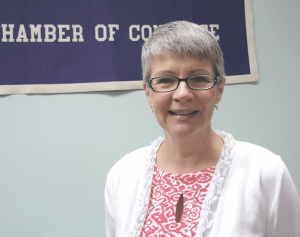
Climate Change
Chambers Respond to a Challenging New Environment

Jeff Ciuffreda says the ACCGS and Springfield Chamber have “retooled” when it comes to the services offered to members.
The president and CEO of the New Bedford Area Chamber and the incoming president of the Mass. Assoc. of Chamber of Commerce Executives (MACE) summoned that phrase to express the sentiment that, while many have a tendency to paint these institutions with one broad brush, they are in many ways very different from one another.
This is true with regard to everything from size to geography to the specific focus of programs and energy within each organization, he said, noting that his chamber, for example, leads a number of initiatives aimed at supporting and growing the New Bedford area’s $1 billion fishing industry.
But despite these apparent differences, chambers across this state — and around the country, for that matter — are facing some common, and formidable, challenges.
Chief among them is membership. It is down for almost all chambers, and by 25% or more at many of them from 10 or even five years ago, said Jeffrey Ciuffreda, president of the Affiliated Chambers of Commerce of Greater Springfield and executive director of the Springfield Chamber. That latter organization had perhaps 750 members five years ago, he said, and now counts roughly 520, a nearly 30% decrease that he described as “typical,” at least in his estimation.
There are several reasons for such drops, said Ciuffreda and others we spoke with. He and Nascimento both mentioned lingering effects from the Great Recession and a related, ongoing trend toward consolidation in many industries — from banking to insurance; from healthcare to the media — that has simply left fewer players to pay dues to a chamber.
But there are other factors, said Ciuffreda, listing everything from competition from other chambers and groups such as young professional organizations to some changing attitudes about chambers on the part of the mostly smaller businesses that now dominate membership rosters.
“Before, the larger, more established corporations joined the chamber because it was the right thing to do, and the chamber was looked upon as the chief cheerleader for that community,” he said. “Now, when you’re out there getting new members, you’re getting mostly smaller businesses that are looking to the chamber for more assistance, guidance, and some advocacy.”
Summing it all up, Ciuffreda described the current environment as “the changing face of chambers,” and said some organizations are reacting to it more quickly and more effectively than others. Overall, chambers are doing things they haven’t done recently, or much at all, he told BusinessWest, mentioning such initiatives as strategic planning, marketing studies, and deep introspection about mission, programming, and ways to bring more value to members and prospective members.
According to Kate Phelon, a relative newcomer to chamber administration — she took the reins of the Greater Westfield organization three years ago — while providing value has always been a key element in any chamber’s success, in this changed environment it is more imperative than ever to provide what amounts to ROI to members.
And this means all members, she said, adding that the Westfield Chamber has been working to identify the needs of specific sectors, or groups, and develop programs to meet them.

Kate Phelon says the Westfield Chamber is focused on finding ways to serve members across all business sectors, from manufacturers to nonprofits.
Kathy Anderson, who segued from Holyoke City Hall, specifically the office of Planning and Economic Development, to the directorship of that city’s chamber 18 months ago, agreed.
She said the Holyoke Chamber has been aggressive in development of new programs, ranging from an ‘Ask a Chamber Expert’ initiative to an endeavor to spotlight the work of manufacturers based in the city, to something called SPARK (Stimulating Potential, Accessing Resource Knowledge), a venture aimed at “fanning the flame of entrepreneurship” (more on these efforts later).
They were all blueprinted, she said, to provide value-added services to different business groups, while also enabling the chamber to “keep changing and evolving, and providing something fresh and different.”
For this issue, BusinessWest takes an in-depth look at this changing face of chambers of commerce, and at what area organizations are doing to adjust to — and thrive in — this new environment.
Matters of Relevance
As he talked about the current climate for chambers and their leaders, Nascimento said there are both challenges and opportunities, and that the common denominator involving elements of each category is the term ‘relevance.’
He used it to describe what chambers must have at a time when they are smaller — at least in terms of membership — than they were years ago, but more is being asked from them, both in the community and from those members.
“Relevance is not a new term, but it is re-emerging within our industry,” he explained. “Is the programming relevant to our members? Is it adding value to our members? Is it providing value to our communities?”
Elaborating, he said that the chambers that are most effectively responding to the changing times are becoming involved in the many facets of economic development — from education to tourism to advocacy — and are becoming more focused on the communities they’re serving.
As examples, he noted his chamber’s work to support the fishing industry — it has helped create what’s known as a ‘seafood buyers mission,’ an event that last year recorded $12 million in sales — and also its work with other groups to revive the region’s convention and visitors bureau, thus bolstering another strong sector of its economy.
There are similar examples from across the state, he said, adding that proactive chambers are changing and getting more involved, again, out of necessity, to gain and retain members.
Indeed, the biggest challenge facing what Nascimento called the “chamber industry” is the same one confronting most all business sectors — ongoing consolidation.
“Our members are merging, they’re being bought out, they’re retiring, and all because of a number of factors — globalization, competition, and others,” he explained, noting that his chamber has seen membership drop from 1,200 to roughly 950 over the past decade or so. “The market out there for traditional members of a chamber are the stakeholders in the business community — your banks, your credit unions, insurance companies, printers, local media, hospitals — and all those industries are consolidating themselves.
“Since I’ve been here over the past seven years, we’ve seen several of our local community banks merge with other community banks that are members,” he went on. “And we’ve seen media merge; at one point, we had a daily newspaper in New Bedford, another daily in a neighboring community, a business publication, and a weekly newspaper in each of the towns. Now, there’s one company that owns them all.”
Similar developments have taken place within the insurance sector, where a number of smaller, family owned agencies have been merged into larger operations; the printing sector; and even office supplies, he said. “We used to have three or four office-supply companies in New Bedford, but they’re all gone — there’s one company, and it’s a regional company.”
This “shrinkage” within the marketplace, as he called it, has left chambers with little choice but to sharpen their focus on services to members and find new — or sometimes old — ways to be relevant.
Ciuffreda agreed, and said the ACCGS and the Springfield Chamber are responding to this challenge in many ways, but mostly a sharper focus on identifying needs and concerns among members — and in the community — and then addressing them.
“We’ve retooled a little bit,” he told BusinessWest, using a word he would come back to often. “When we look at the reasons why people join chambers, it’s clear that we’ve moved on from those days when it was the right thing to do. People are much more focused on services and what they can get out of being a member.”
And this goes beyond benefits such as programs that aggregate small businesses to provide savings on health insurance or discount pharmacy cards, he went on, adding that members are looking for more technical assistance, advocacy, and involvement in key issues.
He said the ACCGS, which has been “in and out” with regard to providing technical assistance to small businesses, will look to get back in if funding can be secured from the state and the private sector. Meanwhile, he said the organization is already more involved in such matters as education and closing the so-called skills gap that is impacting many sectors.
“We’re getting much more involved in education because we are hearing from businesses that want to expand that there is clearly a skills gap,” he noted. “We’re more involved with the school systems, the vocational schools, and the community colleges to try and close that gap.”
Getting Down to Business
The need to effectively identify member needs and tailor a roster of services to meet them is one of many motivating factors behind the ACCGS’s continued involvement in programs with marketing and business students at Western New England University, specifically those taught by marketing professor Janelle Goodnight.
She told BusinessWest that, on several occasions, her students have gathered research on the ACCGS, competing chambers in this region, and chambers in general, and then developed comprehensive marketing plans for consideration.
The latest of these plans will be ready by the end of the fall, she said, adding that, because the ACCGS is a client, she could not get into specifics about what will likely be in the document. But she did say that research conducted last spring revealed that many ACCGS members and prospective members did not fully understand the full range of services the chamber provides, and thus need an education through effective marketing.
Meanwhile, that research also revealed that the chamber’s membership is getting older — “members are aging out” was the phrase Goodnight used — and it is not as diverse, from a demographic standpoint, as the region it serves. Thus, moving forward, two obvious goals are to attract both younger business owners and minority business owners.
The need to more effectively serve members represents one of the many ways in which chambers are very much like the small businesses that dominate their membership roles, said Phelon. They are still coping with the lingering effects of the Great Recession, she noted, but also myriad other issues, ranging from the challenge of understanding and making effective use of technology to mastering the many nuances of social media, to simply finding ways to grow in an environment where it is difficult to do so.
“I have IT issues every day,” she said. “Things are changing constantly … should I get this piece of equipment? How am I going to swipe my credit cards? It’s very hard to keep up, and that’s just one challenge we’re facing.”
Some of the others give credence to Nascimento’s comments about each chamber being different. The Westfield Chamber, for example, serves 10 communities. Westfield and Southwick are home to most members, but the organization’s reach also extends to the small hilltowns (many with populations of 1,000 people or fewer) to the west.
Reaching out to the business owners in these communities, and then convincing them to take part in events and programs several miles down Route 20, can be difficult, she went on, but succeeding in those efforts not only helps the chamber, but it builds a stronger regional business community.
Phelon’s philosophy is summed up in the slogan she puts on the front of her membership packets: ‘The Power of Connectivity.’
She said it refers to the many ways in which the chamber can provide connections — from face-to-face networking events, which she still considers far more effective than social-media outlets, to simply providing information that can help a business owner solve a problem or seize an opportunity.
Phelon said the Westfield Chamber probably had between 400 and 450 members in the late ’80s, but is now roughly half that size, with about 215 at present. While it is not realistic to think the organization can again reach its high-water mark, she said there is certainly room for improvement, and it’s happening, thanks in large part to the hiring of a business development manager.
“Now, we’re actually growing,” she said, noting that, in recent years, new memberships have barely kept pace with the inevitable attrition chambers see each year. “And our ability to keep growing is related directly to our success with providing value to all our members.”
Value Proposition
As she talked about the many new initiatives at the Greater Holyoke Chamber, Anderson said they’ve been developed with several goals in mind. Providing more value to members is obviously one of them, she noted, but beyond that is a desire to help businesses with the challenges that are common to all of them — marketing, gaining new business, and saving money.
One of these concepts, called ‘Ask a Chamber Expert,’ has all these goals in mind.
Started last year, this series of workshops, as the title suggests, enables participants to ask a designated chamber member about some specific subject matter, which to date has included ‘How to Use Facebook to Promote Your Business,’ ‘How to Use LinkedIn as a Connecting Point,’ ‘How to Write a Business Plan,’ and even ‘How to Read a Blueprint,’ a requested program that was comparatively well-attended.
“I certainly learned a lot that day,” said Anderson, adding that the program brings benefits to both those asking the questions and those answering them.
“If I use my own members for these workshops and they become the expert in the room, this gets the people to network and know the businesses within our chamber organization,” she explained. “But it also gives low-cost [$10] advice to members, and if they want more help beyond that and want to hire that person to help them, they can do that.”
Meanwhile, another new initiative is aimed specifically at manufacturers, a constituency that, as Phelon noted, doesn’t directly benefit from many traditional chamber programs, such as after-5 events and breakfasts, where service-related businesses can more easily secure new customers.
The multi-faceted initiative is instead designed to build awareness of manufacturing facilities, said Anderson, noting that such exposure could help generate new business while also introducing young people to potential career opportunities.
“October was Manufacturing Month,” she said, pointing to a full slate of events and programs designed to celebrate and draw attention to that sector. “We had three different tours of manufacturing facilities, and they were open to the public because manufacturers want people to know what they do and what’s being made in the community.”
Another endeavor, in which the chamber will partner with the city’s Boys & Girls Club and, more specifically, with those involved in videography, will place three-to five-minute vignettes about Holyoke-area manufacturers on the chamber’s website.
“This is a value added for them, because they want people to know what they’re doing,” she explained, adding that businesses with specific needs may learn that a Holyoke business can make that part or product. “And down the road, we’re going to have a number of Baby Boomers retiring, and there are questions about who’s going to fill those positions. This program will allow these companies to show what kinds of great jobs there are in our manufacturing businesses.”
And then, there’s SPARK, which is designed to help people bring ideas to reality, said Anderson, by connecting individuals with resources and getting them the support they need. The program will offer mentoring, training, advising, tutoring, teaching opportunities, micro loans and below-market real-estate services, she noted, adding that the name was chosen in part to recognize those who have the ‘spark,’ or desire, to take their dreams to the next level, but need various forms of help to make them happen.
Like Phelon, Ciuffreda, and Nascimento, Anderson also mentioned efforts to partner with other chambers and various economic-development-related organizations to bring still more value to members and bolster the business community or specific sectors within it.
These efforts and the others chronicled above represent a response to the new landscape facing chambers, said Nascimento, adding quickly that the scene didn’t change overnight, and the necessary adjustments won’t come that quickly either.
“There are a lot of challenges for chambers,” he said in conclusion, “but there are also a lot of opportunities. This is an exciting time for chambers and our industry; we’re helping our members, and our communities, with many difficult challenges taking place out there.”
Joining the Fight
While Nascimento contends that if you’ve seen one chamber, you’ve seen just one chamber, these organizations are facing a number of common challenges in a climate seemingly far removed from the one that existed decades ago, when joining the chamber was simply the responsible thing to do.
Words like ‘value’ and ‘relevance’ were not recently added to the chamber industry’s lexicon, but they have certainly taken on new meaning — and importance.
And they will continue to be watchwords in the months and years to come.
George O’Brien can be reached at [email protected]





